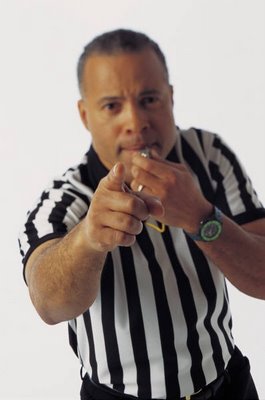
There are a lot of sports that rely on referees and subjective judging. Think about figure skating or gymnastics. You wouldn't think that a sport that started off with dueling where the victor lived and the loser well, you know the rest, would rely so heavily on referees.
But fencing, more specifically the disciplines of sabre and foil, rely on judges to make the call as to which fencer had priority and is awarded a point. This is called "right of way".
WARNING: Long explanation ahead. For those of you who don't want to know all this technical stuff about fencing just move on.
Rules of Right of Way as explained by the US Fencing Association
Right of Way is a theory of armed combat that determines who receives a point when the fencers have both landed hits during the same action. The most basic, and important, precept of right of way is that the fencer who started to attack first will receive the point if they hit valid target. Naturally, fencer who is being attacked must defend themselves with a parry, or somehow cause their opponent to miss in order to take over right of way and score a point. Furthermore, a fencer who hesitates for too long while advancing on their opponent gives up right-of-way to their opponent. A touch scored against an opponent who hesitated to long is called an attack in preparation or a stop-hit, depending on the circumstances.
Additionally, the referee may determine that the two fencers truly attacked each other simultaneously. This simultaneous attack is a kind of tie - no points are awarded, and the fencers are ordered back en garde by the referee to continue fencing.
Please click HERE for more information on rules and more explanations on the sport of fencing.
-------------------------------------------------------------------------------------
Basically, the referee in the sport has a lot of power to determine whether or not you win, so it is really important to make sure you have a referee that abides by the rules. Let's just get real here-sport is not immune to bribery, bias, and politics. Come on, we all know this.
Thus-the international fencing federation has decided to implement the following at the World Championships this year.
1) VIDEO REPLAY
This will allegedly take place from the table of 32 on in the individual events, and from the table of 8 in the team events.
(Supposedly after halt due to a light, the ref will review the last three seconds of action and then make the call.)
2) CHALLENGES (this is like football when the ref has to review the call)
Same as above, top 32 and top 8.
A fencer will have up to 3 challenges per Direct Elimination bout. In the team, a fencer will get one challenge per bout.
***The challenge will be reviewed by the ref and the Head Referee
***If the challenge is successful, the fencer maintains the amount of challenges he/she started with.
***If the challenge is unsuccessful, the fencer receives a warning. Another warning would result in a touch against the fencer.
There are a few comments here:
1. As a fencer I find this totally distracting but I am not going to worry about it. I have decided that if there is a problem, I will let my coach handle it. But all in all this prolonges an already long match.
2. There are a lot of times where a bout is 14-14 and the person wins on a bad call by the referee (bouts in direct elimination go to 15 touches). I can't imagine winning, having the call for me, and then a replay of x amount of minutes has just reversed the win. Wow-so when you win you may not really win. This brings me back to Florida...2000...hanging chads...anyone?
3. Postive: The video replay and challenges can act as a deterrent to bad referees, bribed referees, or biased referees but there are a few questions here.
Is every ref going to be on the same page, meaning an attack to one could not look like an attack to another referee? (For someone who doesn't fence, there are a lot of subtleties in the game at this level) And, how can I trust that the head referee isn't going to be biased? Is this just a waste of time?
Ultimately all changes in fencing occur as an effort to increase viewership of the sport and in turn marketability. Fencing federations are driving themselves (and the fencers) crazy by trying to change the way the game is played just to make it appealing to the viewer.
There was a stint with a clear mask but the Plexiglas was determined to be too unsafe. My sister, an engineer, had some of her friends test the durability and the safety of the mask when the mask first came out. Her friends just laughed and said-I can't believe you would wear this while someone is jabbing a weapon at your face. It's a good thing the FIE did all this useful testing AFTER all fencers were required to wear the mask during competition. Once again, the athlete is compromised in the name of commercialism. Let me not get into it.
In the end I think the video replay is going to be distracting and I think it will be distracting for the viewer.
The question to the audience is-what do you think about video replay in fencing? Is there ever going to be a way way to change the sport of fencing to make it more marketable? And at what point will enough be well, enough? Where do we draw the line between compromise and selling out our sport?
